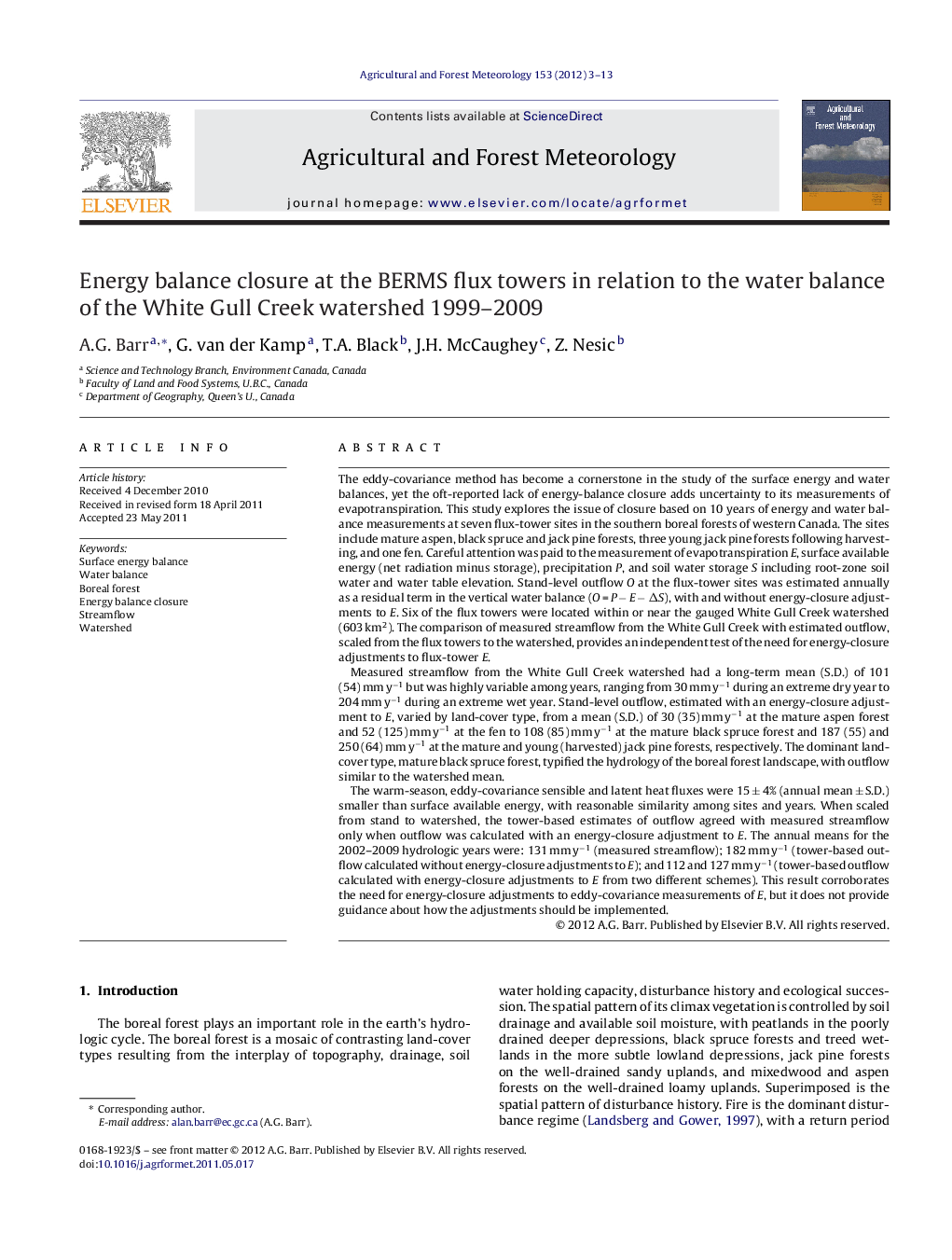| کد مقاله | کد نشریه | سال انتشار | مقاله انگلیسی | نسخه تمام متن |
|---|---|---|---|---|
| 82132 | 158375 | 2012 | 11 صفحه PDF | دانلود رایگان |

The eddy-covariance method has become a cornerstone in the study of the surface energy and water balances, yet the oft-reported lack of energy-balance closure adds uncertainty to its measurements of evapotranspiration. This study explores the issue of closure based on 10 years of energy and water balance measurements at seven flux-tower sites in the southern boreal forests of western Canada. The sites include mature aspen, black spruce and jack pine forests, three young jack pine forests following harvesting, and one fen. Careful attention was paid to the measurement of evapotranspiration E, surface available energy (net radiation minus storage), precipitation P, and soil water storage S including root-zone soil water and water table elevation. Stand-level outflow O at the flux-tower sites was estimated annually as a residual term in the vertical water balance (O = P − E − ΔS), with and without energy-closure adjustments to E. Six of the flux towers were located within or near the gauged White Gull Creek watershed (603 km2). The comparison of measured streamflow from the White Gull Creek with estimated outflow, scaled from the flux towers to the watershed, provides an independent test of the need for energy-closure adjustments to flux-tower E.Measured streamflow from the White Gull Creek watershed had a long-term mean (S.D.) of 101 (54) mm y−1 but was highly variable among years, ranging from 30 mm y−1 during an extreme dry year to 204 mm y−1 during an extreme wet year. Stand-level outflow, estimated with an energy-closure adjustment to E, varied by land-cover type, from a mean (S.D.) of 30 (35) mm y−1 at the mature aspen forest and 52 (125) mm y−1 at the fen to 108 (85) mm y−1 at the mature black spruce forest and 187 (55) and 250 (64) mm y−1 at the mature and young (harvested) jack pine forests, respectively. The dominant land-cover type, mature black spruce forest, typified the hydrology of the boreal forest landscape, with outflow similar to the watershed mean.The warm-season, eddy-covariance sensible and latent heat fluxes were 15 ± 4% (annual mean ± S.D.) smaller than surface available energy, with reasonable similarity among sites and years. When scaled from stand to watershed, the tower-based estimates of outflow agreed with measured streamflow only when outflow was calculated with an energy-closure adjustment to E. The annual means for the 2002–2009 hydrologic years were: 131 mm y−1 (measured streamflow); 182 mm y−1 (tower-based outflow calculated without energy-closure adjustments to E); and 112 and 127 mm y−1 (tower-based outflow calculated with energy-closure adjustments to E from two different schemes). This result corroborates the need for energy-closure adjustments to eddy-covariance measurements of E, but it does not provide guidance about how the adjustments should be implemented.
► Stand-level outflow was computed as a water balance residual at seven flux towers.
► Eddy-covariance heat fluxes underestimated surface available energy by 15%.
► Outflow agreed with measured streamflow only after closure adjustments to ET.
► The black spruce stand typified the boreal forest landscape hydrologically.
Journal: Agricultural and Forest Meteorology - Volume 153, 15 February 2012, Pages 3–13